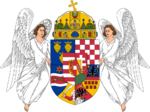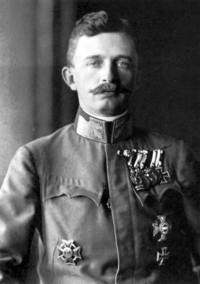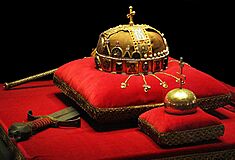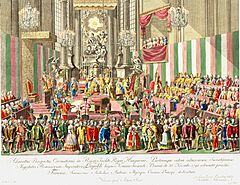King of Hungary facts for kids
Quick facts for kids Apostolic King of Hungary |
|
|---|---|

|
|

Last to reign
Charles IV |
|
| Details | |
| Style | His/Her Apostolic Majesty |
| First monarch | Stephen I |
| Last monarch | Charles IV |
| Formation | 25 December 1000 |
| Abolition | 16 November 1918 |
| Residence | Buda Castle |
| Appointer | Hereditary |
| Pretender(s) | Archduke Karl |

The King of Hungary (Hungarian: magyar király) was the main ruler of the Kingdom of Hungary. This title was used from the year 1000 (or 1001) until 1918. The special title "Apostolic King of Hungary" was approved by Pope Clement XIII in 1758. After that, all Hungarian kings used this longer title.
Contents
Becoming King of Hungary
Before the year 1000, Hungary was not yet a kingdom. Its ruler was called the Grand Prince of the Hungarians. The first King of Hungary was Stephen I. He was crowned on December 25, 1000 (or January 1, 1001). He received his crown from Pope Sylvester II with the approval of Otto III, Holy Roman Emperor.
After King Stephen I, all rulers of Hungary from the Árpád dynasty used the title "King." However, not everyone who ruled Hungary was a king. For example, Stephen Bocskai and Francis II Rákóczi were called "High Princes." There were also three "Governors" or "regents" who ruled for a time: János Hunyadi, Lajos Kossuth, and Miklós Horthy.
How a King Became Official
From the 1200s onwards, there were clear rules for a person to become the true King of Hungary. To be a legitimate king, three things had to happen:
- The king had to be crowned by the Archbishop of Esztergom.
- The king had to be crowned with the Holy Crown of Hungary.
- The coronation had to take place at Székesfehérvár Basilica.
These rules helped protect the Kingdom's power. It meant that just stealing the Holy Crown was not enough to become the rightful king.
For example, King Béla III was crowned by a different archbishop. But he later made sure that only the Archbishop of Esztergom could crown future kings. In 1211, Pope Innocent III agreed, saying only the Archbishop of Esztergom had this right.
Charles I of Hungary was crowned three times to make sure his rule was fully legitimate. His first two coronations didn't use the Holy Crown or weren't in the right place. His third coronation in 1310 followed all the rules. It happened in Székesfehérvár, with the Holy Crown, and by the Archbishop of Esztergom.
Sometimes, people tried to bend the rules. In 1439, Queen Elizabeth of Luxemburg had the Holy Crown stolen. She then had her baby son, Ladislaus V, crowned. This coronation followed the rules, making him a legitimate king.
Later, Matthias Corvinus had to get the Holy Crown back from Frederick III, Holy Roman Emperor. Once it was returned, Matthias was properly crowned and became the rightful king.
Who Inherited the Throne?

Like in most old monarchies, the next king was usually a male relative of the previous king. In Hungary, sometimes younger brothers would become king before the previous king's own son. This often led to family arguments.
The first royal family of Hungary was founded by Árpád. He led his people into the Carpathian Basin in 895. His family ruled for over 400 years. Famous kings from this family include Saint Stephen I and Saint Ladislaus I.
In 1301, the last member of the House of Árpád died. Charles I became king. He claimed the throne because his grandmother, Mary, was the daughter of a previous king.
Later, the direct line of kings was broken again in 1395. This happened when Queen Mary, a granddaughter of Charles I, died. Her husband, Sigismund, continued to rule. He was chosen by the nobles of the Kingdom.
Sometimes, kings were chosen by the nobles, not just born into the royal family. Matthias Corvinus was the first Hungarian king from a noble family, not a royal one. He was elected by the nobles. The same happened with John Zápolya in 1526. He was chosen after King Louis II died in the battle of Mohács.
After this, the House of Habsburg took over the throne. They ruled Hungary from Austria for nearly 400 years, until 1918. After World War I, Admiral Horthy became regent in 1920. However, Charles IV of Hungary's attempts to retake the throne were not successful. The monarchy in Hungary officially ended on February 1, 1946. This was when the Second Hungarian Republic was formed.
Other Titles Used by the King
Over many centuries, the Kings of Hungary gained control or claimed lands in nearby countries. Because of this, they started using royal titles from those places. By the time of the last kings, their full title was very long. It included: "By the Grace of God, Apostolic King of Hungary, Dalmatia, Croatia, Slavonia, Rama, Serbia, Galicia, Lodomeria, Cumania and Bulgaria, Grand Prince of Transylvania, Count of the Székelys".
The special title "Apostolic King" was confirmed by Pope Clement XIII in 1758. All kings of Hungary used it after that.
The title "King of Slavonia" referred to lands between the Drava and Sava Rivers. Ladislaus I was the first to use this title. He also adopted the title "King of Croatia" in 1091. Coloman added "King of Dalmatia" in 1105.
The title "King of Rama" meant a claim over Bosnia. Béla II first used it in 1136. Emeric adopted the title "King of Serbia".
The phrase "King of Galicia" showed control over Halych. "King of Lodomeria" referred to Volhynia. Both titles were adopted by Andrew II in 1205. In 1233, Béla IV started using "King of Cumania." This meant ruling over lands where the Cumans lived, like Wallachia and Moldavia. The title "King of Bulgaria" was added by Stephen V.
Transylvania was once part of the Kingdom of Hungary. It was ruled by a voivode. After 1526, it became a semi-independent principality. It was under the Ottoman Empire and later the Habsburg monarchy. In 1696, Leopold I took the title "Prince of Transylvania". In 1765, Maria Theresa made Transylvania a Grand Principality.
The "Count of the Székelys" was an important official in Hungary. Later, the Princes of Transylvania used this title. Maria Theresa brought the title back at the request of the Székelys people.
How Long Kings Ruled
Kings Who Ruled the Longest
|
Kings Who Ruled the Shortest
|
||||||||||||||||||||||||||||||||||||||||||||||||||||||||||||||||||||||||||||||||||||||||||||||||||||||||||||||||||||||||||||||||||
See also
- Apostolic King
- Grand Prince of the Hungarians
- Lands of the Crown of Saint Stephen
- Regent of Hungary

